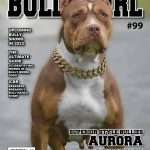
American Bullys and Pitbulls come in a variety or colors. Some are black , others white, fawn, blue and tri colors. Another color which seems to be newer choice on the color wheel is called ” merle”.Breeders like to entice less knowledgeable buyers with using words like rare or new color to make the buyer think they are getting either the up and coming fad or something truly special worth paying top dollar for. What is Merle? Merle is a solid base coat ; of any color; with spots splotches and patches covering it. Merle dogs also often exhibit mismatched eye color or blue eyes. Merle seems to be a topic which requires some investigation since it appeared recently and the pit bull itself in a whole array of colors excluding merle has been around for hundreds of years.
Merle is the only color which is an instant disqualification from the show ring in the pit bull/ american bully show classes. The reason Merle is not allowed in the show ring is that it is clear and outright evidence of crossbreeding and show dogs are meant to be purebred. IT is believed the color comes from the crossbreeding of pit bulls to Catalaoula Leopard dogs.
Merle coloration is considered a flaw not only because it is direct evidence of crossbreeding, but it is also associated with health risks. Merle can really be summed up as lack of color pigments causing weird designs and variations in skin and eye colors. To touch on the surface of the genetics, there are 2 types of Merle, the heterozygous Mm and the homozygous mm.A capital M means a merle allele responsible for merle coloring of the coat as dominant ( obvious in appearance)A lower case m means an allele responsible for normal coat pigmentation ( not usually visible to the naked eye). These letters can be combined as MM , mm , Mm, mM to create many abnormalities and disabilities and oh yes, colors too.
Both types are merle are prone to eye and ear abnormalities. partial to total deafness and poor eye sight due to intraocular pressure.Both issues are associated with the lack of pigment. Hearing loss is attributed to absence of pigment in the eye passage hairs. Limited visibility or eye sight issues come from visibility less pigment in the eye ( lack of eye color).The MM type is also associated with abnormalities of the skeletal system, cardiac ( heart) and reproductive systems.
Merle enthusiasts have tried to place their claim that the color has always been there but is just now becoming more widespread therefore should be allowed into the accepted category, however the National Pitbull Association feels that colors do not just pop up overnight without clearly unethical conduct to produce it, and that at this point the color will in no way be considered an acceptable color for the breed.
Feel free to do your own research on the matter but to purposely breed a dog with any chance let alone a high chance of blindness a deafness should definitely have a strong stance taken against it.










It is CataHOUla. Spell check.
Second, merles come in blue and red and tris. Don’t breed to blue together and you won’t get what is called the White Factor. And be very careful when breeding blue eyed dogs. You don’t want another blue eyed dog in at least 2 generations. If you selectively breed so you have no multiple generations of blue eyes and the white factor you don’t get deaf dogs or blind dogs.
Third, APBT have never come in merle. If someone is out there claiming it now, it is BS. The old fight about the blue color is a whole different story as there is plenty of proof that the old Imp line carried the blue coat color.
American Bullies are prone to all kinds of health problems by the very manner in which they are bred for the exaggerated bowed legs, short legs, extreme smashed muzzles, etc.
Do your homework and stay away from backyard breeders!